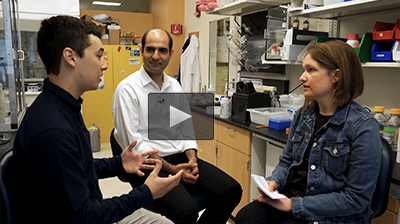Instructor Insights
7.341 The Microbiome and Drug Delivery: Cross-species Communication in Health and Disease is an undergraduate seminar course developed by MIT instructors/postdocs under the supervision of Professor Bob Horvitz (MIT Koch Professor and 2002 Nobel Laureate in Medicine). The instructors were responsible for developing the whole course syllabus, homework, midterm, and final evaluations as well as teaching all the class sessions independently.
In the following video, Drs. Ali Beyzavi and Miguel Jimenez describe various aspects of how they taught the course.

An Interview with Ali Beyzavi and Miguel Jimenez on Teaching the Microbiome and Drug Delivery
View by chapter:
- The Crux of the Class: Critically Reading the Primary Literature
- The Role of Instructor-led Questioning
- The Mid-term Assignment: Solving a Puzzle
- The Final Presentation: A Chance to Assess How Well Students Understood the Purpose of the Course
- Real-world Applications: Visiting a Synthetic Biology Company
- Teaching the Course as Post-Docs: An Opportunity to Give Back to the Community and to See Your Own Research from a Different Perspective
Curriculum Information
Prerequisites
- 7.03 Genetics
- 7.05 General Biochemistry
- 7.06x Cell Biology
- 7.28x Molecular Biology
Requirements Satisfied
Unrestricted elective credits
Offered
Advanced Undergraduate Seminars are offered nearly every semester and are on various topics. This was the first time this specific topic was offered.
Assessment
Grade Breakdown
The course is graded as “pass” or “fail.” A passing grade is given to students who attend the class, participate in discussions, and complete both assignments in a satisfactory manner.
Student Information
Enrollment
Fewer than 10 students
Breakdown by Year
Primarily seniors
Breakdown by Major
Primarily Biology majors
Typical Student Background
The course targeted students not only from the biology department but also from the engineering departments; the goal was to have a class that could read and discuss papers dealing with both drug delivery and the biology of the microbiome and signaling between cells.
How Student Time Was Spent
During an average week, students were expected to spend 6 hours on the course, roughly divided as follows:
In Class
- Met once per week for 2 hours per session; 14 sessions total; mandatory attendance
- In the first part of each week’s class, students discussed and evaluated the papers that comprised the readings for the week.
- At the end of each class, the instructors gave a short introduction to the papers for the following week.
Out of Class
Each week, students read two papers from the primary research literature and critically evaluated these papers focusing on experimental design, control experiments, methods and interpretation of the data.










